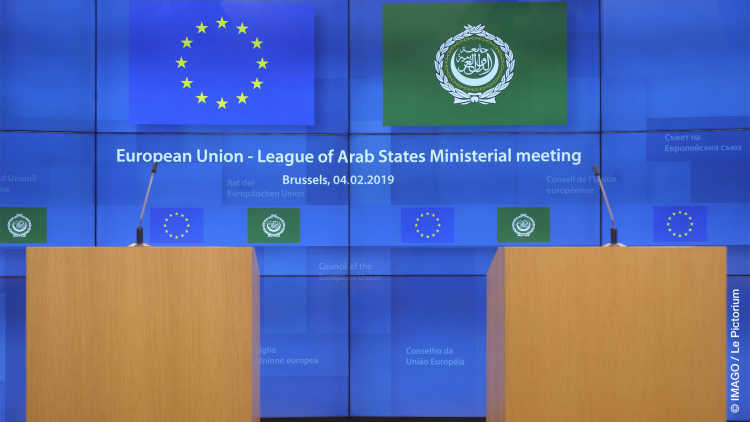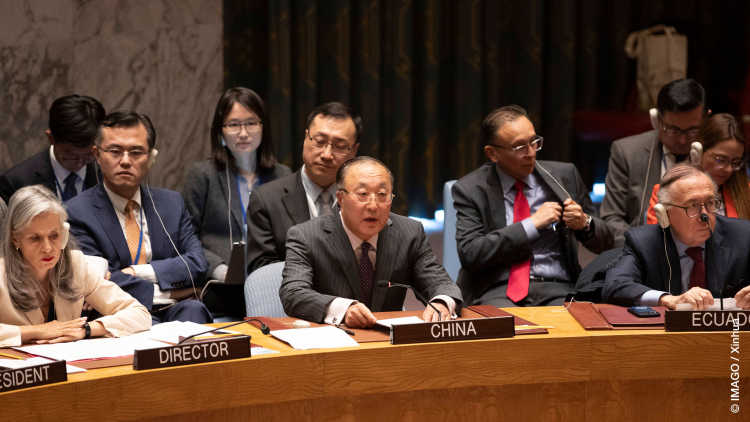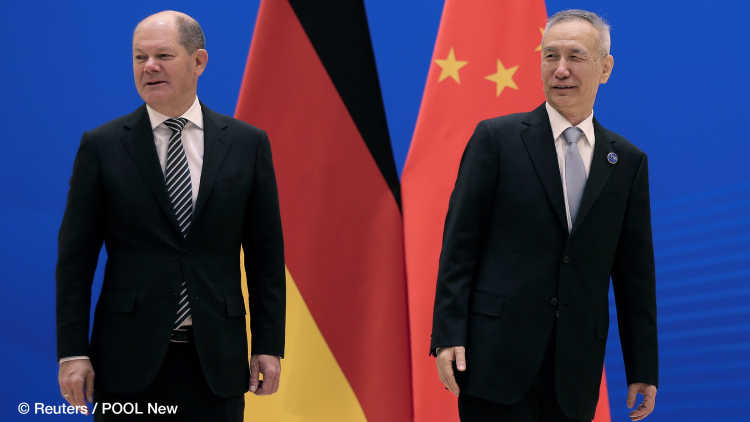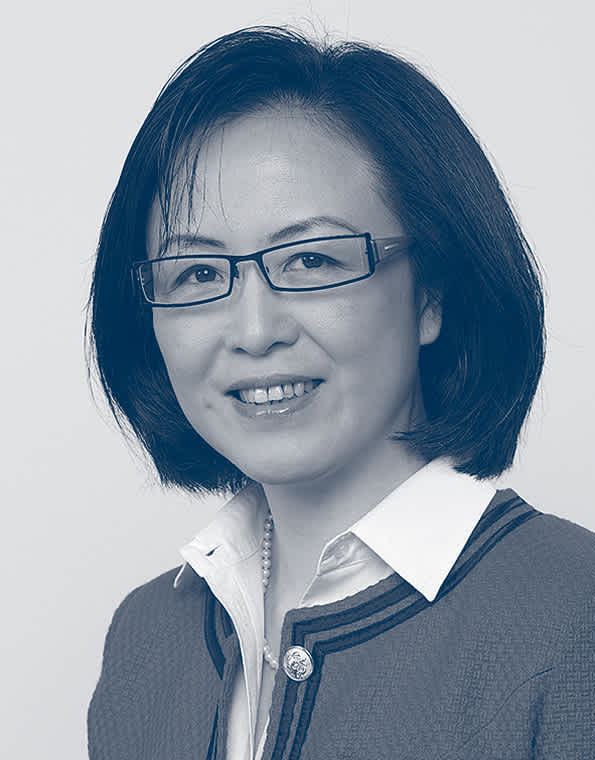- Startseite
- Publikationen
- GIGA Focus
- Disengagement from China: United States and European Union Policies Compared
GIGA Focus Asien
Disengagement from China: United States and European Union Policies Compared
Nummer 1 | 2023 | ISSN: 1862-359X

In contrast to the United States’ unilateral China policy under President Donald Trump, the Joe Biden administration has renewed its ties with European and Asian allies. In its struggle with China for supremacy, the US strives to build a “united front” based on similar values. Although European countries share many values with the US, the China policies of the European Union and some of its member states substantially differ, not least due to diverging threat perceptions and economic interests.
Against all expectations, the Biden administration continued Trump’s policy of containing China’s development through tariffs, exports controls, investment blockades, and visa restrictions. With the US CHIPS and Science Act and new export controls, the US government seeks to slow down China’s further technological rise.
Security issues have become more important in both the US and EU approach. European countries are, however, still reluctant to apply the same threat assessment for China as for Russia and to disengage from China.
Europe’s dependency on China as a key market and production base is still high, and most EU member states are not yet prepared for an economic decoupling.
Although governments and research institutes in Europe have become more aware of the risks of science and technology cooperation with China, to discontinue it is not seen as an option.
Despite the US and EU attempting to coordinate their China policies, the new US export controls on semiconductors were criticised by many European companies as unilateral decisions.
The US and EU struggle to align their diverging interests on important topics such as the use of subsidies to support their economies. Therefore, the chances of them developing a unified China policy remain limited.
Policy Implications
The relationship between the US and China has turned into a new Cold War in which the coexistence of different economic and political systems does not seem possible. For European countries, decoupling from China would undermine economic stability. Instead, the EU should further cooperate with China following an interest-led policy based on the principles of openness and rules-based multilateralism.
Continuing Donald Trump’s Political Legacy
Although United States–China relations have faced many ups and downs in recent decades, it was under the Trump presidency that the US’s China policy turned from one of engagement to one of strategic competition. As to why this paradigmatic policy change took place, McCourt (2022) analyses the various dimensions of engagement and the role of knowledge communities in US China policy. McCourt sees Trump’s election to the presidency as a critical juncture for the end of engagement in the diplomatic, military, and economic spheres. That Trump’s election campaign was able to change the general narrative on China was a precondition for this fundamental policy shift. Prior to the 2016 elections, the policy frame had been based on the notion that China’s rise did not represent a threat to the US. In sharp contrast, under the Trump administration China was now defined as an economic rival, security threat, and ideological competitor.
When President Joe Biden took office in January 2021, he declared himself to be in no hurry to depart from his predecessor’s policies and practices towards China. His nominee for Secretary of State, Antony Blinken, announced plans for a multilateral approach to foreign policy including closer cooperation with Western allies to maximise the US’s leverage on China. The Biden administration’s tough stance on China can be interpreted as a reaction to opinion polls and thus driven by the idea of winning also Republicans’ general support for its policies. In its survey on domestic views of China conducted from 1 to 7 February 2021, the Pew Research Center (2021) found that interviewees had less confidence in Biden dealing as effectively with China (53 per cent) as with world affairs in general (60 per cent). The difference in confidence between Democrats (83 per cent) and Republicans (19 per cent) was even stronger. Large partisan divides existed on many other China-related issues as well, with the exception of human rights (Silver, Devlin, and Huang 2021).
In early June, the US Senate passed the United States Innovation and Competition Act of 2021. This demonstrates the Biden administration used the opportunity at hand to pursue bipartisanship on its China policy and therewith attempt to win broad support in Congress. The Act’s policy goal is the US’s sustained global leadership role in competition with China. It provides USD 250 billion of investment in a number of emerging technologies, focusing on the interconnectivity between academic research, government grants, venture capital, and free-market competition.
US–China Technology War: Focus on Semiconductors
China’s fast technological rise has been perceived as a security threat by successive US governments. The Barack Obama administration had already implemented a broad set of containment measures, including restrictions on investment in American high-tech companies and an export-control system that excluded China from access to many advanced technology products. The Biden administration not only continued Trump’s even stronger containment policy towards China but tightened its own policy measures as well. The bipartisan CHIPS and Science Act, signed into law on 9 August 2022, and the complementary new export controls on artificial intelligence and semiconductors published by the U.S. Department of Commerce’s Bureau of Industry and Security (BIS) on 7 October of the same year, represent the core of this new and very comprehensive containment policy.
According to the White House Briefing of August 8, the CHIPS and Science Act is designed to play a crucial role in enabling the US to “win the race for the 21st century” and to “keep the United States the leader of the industries for tomorrow, including nanotechnology, clean energy, quantum computing and artificial intelligence.” As for the BIS, meanwhile, the aforementioned export controls aim to restrict China’s “ability to both purchase and manufacture certain high-end chips used in military applications.” These new controls are the most comprehensive in scope to date, representing a major shift. Instead of using export controls to maintain relative advantage over competitors, this new policy obstructs China’s access to US semiconductors. In line with National Security Advisor Jake Sullivan’s request to “maintain as large of a lead as possible,” the US government argues that China’s military–civil fusion doctrine renders it difficult to distinguish between civilian and military end-users (all quotes from Reynolds 2022).
To achieve the BIS’s goals, the new export controls exclude China from buying US high-end AI semiconductors; this restriction also applies to US-owned entities in China. In addition, Chinese companies are also excluded from access to chip-design software, chip-manufacturing facilities, as well as manufacturing equipment. The fact that the US occupies a dominant position in the global chip-design market with three leading companies in the field of semiconductor electronic design automation implies a strong disadvantage for China. Prohibiting semiconductor-manufacturing companies worldwide from providing services to Chinese chip designers using US-designed software means that they will hardly be able to manufacture high-end chips for AI or supercomputing outside of China. US dominance also exists in advanced semiconductor-manufacturing facilities. Therefore, export restrictions on these facilities, on support teams and spare parts, as well as on components will also harm the development of the Chinese semiconductor industry (Allen 2022).
The tightening of export controls, however, could result in lower revenue for and less innovation by US companies. Reynolds (2022) points to certain economic repercussions for major US companies in the field of semiconductor manufacturing that rely on China as their largest revenue market. They usually invest profits from selling legacy (older) equipment in innovation and staying competitive regarding high-end equipment. In contrast, Chinese companies focusing on the development of domestic semiconductor manufacturing could increase their sales and revenues and be able to invest more in innovation. There are also other unintended consequences of the trade curbs. If, for example, China boosts the production of low-end chips, driving down prices and outcompeting US and other Western companies, the strong dependency of Western countries on Chinese suppliers for such chips could be the eventual result.
Under the growing pressure exerted by the US’s containment policy, the Chinese government has increased its support for the domestic semiconductor industry. Despite the progress made, China’s dependency on semiconductor imports is still extremely high. According to recent data from TrendForce, China’s share of global chip design came to only 2 per cent, that of chip manufacturing varied – depending on the quality – between 5.5 and 10 per cent, while the market share for packaging and testing was 25 per cent in the first quarter of 2022. While China’s manufacturing of legacy chips has rapidly increased in recent years, the development of more sophisticated chips still lags behind. According to estimates, Chinese chip companies were able to satisfy 13 per cent of local demand in 2013; in 2022, this figure is expected to have stood at 26 per cent (Bork 2022).
Whether the containment policy will be effective depends on how well the controls can be implemented and how fast China’s domestic semiconductor industry adapts. For its unilateral containment policy to be successful, the US will need support from Taiwan as well as from countries with a semiconductor industry such as South Korea, Japan, and some European nations. With South Korea having strongly invested in semiconductor manufacturing in China, Korean companies in China will possibly not accept denial of a licence to import high-end semiconductors (Allen 2022).
The European Union’s China Policy: Between Threat and Challenge
In contrast to US China policy, the idea of disengagement from China had not received much support in Europe before the Russian invasion of Ukraine in February 2022. However, the war’s commencement altered the view of China for the worse across Europe. Public perception of China reached its lowest level to date. Stronger focus was put on common security and national sovereignty. Germany’s reorientation of its defence policy is a case in point here (Chen et al. 2022). As an immediate reaction to the return of war in Europe, the Council of the European Union published “A Strategic Compass for Security and Defence” on 21 March 2022. According to the Council’s assessment of the EU’s strategic environment, China is not only referred to as cooperation partner, economic competitor, and system rival but also as military power impacting regional and global security.
In the discussion of whether China should be treated as a security threat or challenge, NATO’s view has changed in recent years as well. In June 2021, NATO classified Russia as a security threat in its summit’s closing statement but called China a challenge. One year later, NATO members' perception of China had become more critical, especially due to the country’s close relationship with Russia. In its “Strategic Concept,” adopted by heads of state and government at the summit held in Madrid on 29 June 2022, NATO criticised how the
deepening strategic partnership between the People’s Republic of China and the Russian Federation and their mutually reinforcing attempts to undercut the rules-based international order run counter to our values and interests.
The threat NATO ascribes to China is, however, not the same as it does to Russia: “We will work together responsibly, as Allies, to address the systemic challenges posed by the PRC to Euro-Atlantic security.”
At the EU-China Summit in Beijing at the beginning of December 2022, European Council president Charles Michel and Chinese president Xi Jinping exchanged views on geopolitical, economic, and global issues. According to the EU press release of 1 December 2022 that followed the meeting, Michel emphasised that communication channels with China need to remain open and be used effectively: “With China, engaging openly on all aspects of our relationship is the only way forward.” It can be expected, however, that the same topics that were discussed at the 2022 December summit – especially the war in Ukraine, the energy and food crises, human rights, and Taiwan – will again be on the agenda of the next EU-China Summit in 2023, with no common understanding hereon having yet been reached.
Strong divisions among European policy elites over how to deal with the country make it difficult for the EU to develop a unified China strategy. Within the EU there are dove and hawk policymakers, the latter preferring a tougher line on China – especially with regards to human rights and Taiwan. In contrast, doves want to maintain cooperation with China and avoid policy measures that could have a negative impact on economic relations. There is also a rift running through institutions, sectors, and governments between trade-focused doves on the one hand and the hawkish proponents of a “values-based” foreign policy on the other. Germany represents a good example of this complex situation. So far, Chancellor Olaf Scholz has been able to implement a pragmatic China policy despite resistance from various ministries in his own government pushing for a tougher line being taken. Much-debated was the investment of a Chinese company in the Port of Hamburg, taking the form of a minority stake in one of the harbour terminals. Scholz’s pro-investment intervention offered the compromise to further reduce the stake to under 25 per cent, and thus made the transaction possible. In his article for the US-based journal Foreign Affairs – “The Global Zeitenwende – How to Avoid a New Cold War in a Multipolar Era” – that was published in early December 2022, Scholz conveys his position on how to best deal with China. First, he clearly rejects the notion that a new Cold War – this time between the US and China – is unavoidable. Second, he argues that we are faced with the end of an exceptional phase of globalisation and the emergence of China as a new global player. He emphasises that
China’s rise does not warrant isolating Beijing or curbing cooperation. But neither does China’s growing power justify claims for hegemony in Asia and beyond. (Scholz 2022)
Economic Dependency on China: EU and Germany
For most European countries, economic relations with China play a crucial role in their thinking. Due to the respective member states’ different degrees of economic cooperation with China and varying efforts to assess dependencies, the picture is mixed. Against the background of the Russian war on Ukraine and the fact that authoritarian states are willing to utilise scarce commodities as tools of foreign policy leverage, European dependence on trade with China is now being discussed critically within the EU (Chen et al. 2022).
A recently published report by the European Think-tank Network on China (ETNC) presents data from 17 EU member states and the United Kingdom revealing their huge differences in terms of economic dependence on China (Seaman et al. 2022). When dividing these countries into four categories according to the intensity of public debate, policy-level assessments, and to the understanding of their dependencies on China, marked contrasts become apparent. Surprisingly, in only a minority of countries that have strong trade relations with China was intense debate on such dependence associated with policymakers giving high priority to this challenge.
In his study on Europe’s economic interdependence with China, Zenglein (2020: 2) points to the strong increase in the volume of bilateral trade between 2000 and 2019. In his eyes, the COVID-19 pandemic illustrated that both trade partners were mutually interdependent, with Europe’s needs here mostly hinging on imports from China for the pharmaceutical, chemical, and electronic sectors. The author found that the EU exhibits critical strategic dependence in 103 product categories regarding electronics, chemicals, minerals/metals, and pharmaceutical/medical products. Zenglein (2020: 5) further defines strategic dependence on China as follows: the EU is a net importer of a good, it imports more than 50 per cent of that good from China, and China controls more than 30 per cent of the global market for that good. Though the EU needs to consider its long-term national security interests and vulnerabilities, Zenglein concludes that preserving a balanced degree of economic interdependence would be for the benefit of both the EU and China.
With Germany being China’s most important economic partner in Europe, critics question whether the country has learned from its energy dependency on Russia and whether it is prepared to adapt its China policy. Based on the OECD’s TIVA (Trade in Value-Added) database, Matthes (2022: 22) shows that China’s trade dependence on the EU was only slightly higher than the other way around in 2018 (latest available data). Germany, however, was more dependent on trade with China than vice versa, especially with regards to exports. Although a similar degree of dependency among trading countries has a stabilising effect, Matthes points to diverging trends here: while the trade dependency of the EU and Germany on China has been increasing, the latter has been able to reduce its own reciprocal dependence thereon.
As a response to critics who argue that Germany’s trade dependence on China is too high, the president of the EU Chamber of Commerce in China, Joerg Wuttke, downplayed these concerns, stating that many of Germany’s imports from China were replaceable. Nevertheless, he sees a strong dependence on three levels: as a consumer market, as a production base, and as a provider of some key products, especially rare earths and pharmaceutical precursors for which Germany had better diversify its sourcing. Wuttke deems the dependency discussion to be “totally overblown”: “Like any commercial relationship, working with China is about managing risks.” While Germany would need to reduce its dependency and diversify its sourcing, he disagrees with making any radical policy changes: “What needs to happen is not decoupling, abandoning economic interdependence, or even signing onto some form of containment policy” (Wuttke, as quoted by Tan 2022).
This discussion reveals that precise criteria to assess which exact level of dependence represents a challenge or threat are currently lacking. During the COVID-19 pandemic, when supply chains were interrupted, it became obvious that countries need a certain degree of technology sovereignty. Following the definition of “technology sovereignty” proposed by experts from the Fraunhofer Institute for Systems and Innovations Research ISI, it is about
the ability of a state or a federation of states to provide technologies it deems critical for welfare, competitiveness, and its ability to act, and to be able to develop these or source them from other economic areas without one-sided structural dependency. (Edler et al. 2020: 8)
Important elements in this approach include the classification of certain technologies as “critical,” the analysis of the ability to produce them, and the associated risk of sourcing such technologies from abroad. The Fraunhofer Institute’s position paper underlines that, given geopolitical uncertainties and increasing protectionism by various global players, only a common European perspective on technology sovereignty is future-proof. Due to the close economic and political integration of EU member states, politically induced supply-chain disruptions within Europe seem unlikely.
EU–China Cooperation: Research and Technology
China has become an important cooperation partner for the EU in science and technology (S&T). Unlike the US, the EU does not perceive China’s fast rise in S&T as first and foremost a threat. In recent years, however, following China’s strong support for the development of new and emerging technologies and its S&T strategy of military–civil fusion, the EU has adapted its international cooperation strategy. In May 2021, the European Commission published a communication on its global approach to research and innovation (R&I) entitled “Europe’s Strategy for International Cooperation in a Changing World,” adopted by the Council on 28 September 2021. This approach is based on the idea that global openness is needed to drive excellence, that resources have to be pooled to achieve progress, and that a vibrant innovation ecosystem is required for success. The fundamental R&I principles and values of the global approach include academic freedom, gender equality, research ethics, open science, and evidence-based policymaking. In its “Outcome of Proceedings, Global Approach to Research and Innovation,” the Council called on the Commission to continue negotiations with China on a joint road map “to establish agreed framework conditions and guiding principles for cooperation to reach a level playing field and reciprocity.” In addition to new policy measures developed at the EU level, national governments are also taking steps to safeguard research integrity and security.
Like the US, the EU is also updating its support for the semiconductor industry and its ecosystem. In February 2022, the Commission presented a proposal for an EU Chips Act with the objective to strengthen the whole EU chips value chain, including regarding capacity-building and the safeguarding of supply. Due to semiconductor shortages, European car manufacturers had been forced to temporarily shut down factories, lay off workers, and reduce their output in 2021. With less than 10 per cent of global semiconductor production – 37 per cent thereof in the automotive sector – being located in Europe, companies depend on Asia – in particular on Taiwan, South Korea, and Japan – for advanced chip manufacturing and chip design (further to on the US). By 2030, the European Chips Act will facilitate innovation, improve production capacities, and address skill shortages. In addition to the EUR 43 billion policy-driven investment in this initiative, the European Commission expects about the same amount to be provided by long-term private finance too (Wieringen 2022).
An Interest-Led China Policy on Both Sides
Faced with a near-peer rival, the US is focused on containing China’s technological advancement in order to stay ahead as global leader. While the Biden administration has been trying to form an anti-China tech alliance, diverging interests in Europe and the US make a unified approach difficult here. European companies, for example, worry that the unilaterally decided new US export controls on semiconductors work to their disadvantage, leading to a decline in sales and profits. With US technology being part of almost all semiconductor supply chains, Biden and his successors will be able to apply these controls abroad as well, while also stopping semiconductor sales extraterritorially.
Although the US-EU Trade and Technology Council (TTC) was established as a new forum in December 2020 designed to “coordinate approaches to key global technology, economic, and trade issues; and to deepen transatlantic trade and economic relations,” it is not being used to negotiate and solve current problems between the two sides as related to their divergent interests. One of these issues concerns incentives for US consumers purchasing electric vehicles that contain locally sourced battery elements. This policy is part of the Inflation Reduction Act signed into law by President Biden on 16 August 2022. Europeans worry that these subsidies invite European car manufacturers and producers of climate-mitigating technologies to relocate their facilities to the US, thereby directly going against European interests. Another example of how complicated it is to align US and European interests is the discussion of a joint road map towards a shared AI terminology and related technical standards. Finding common ground for regulating AI technology is a challenge, given the precondition that joint work “does not constrain or prejudge the regulatory activities of the two parties” (Matthews 2022).
Comparing US and European China policies of recent years reveals a widening gap. Despite the negative impact of the Russian war on Ukraine vis-à-vis European perceptions of China, EU member states are reluctant to apply to the same threat assessment for China as for Russia. While the Biden administration’s China policy is fixated on competition and national security, and preoccupied with renewing US global leadership, the EU essentially remains open to cooperation – even though it also has become more critical of China recently. To manage these transatlantic differences and continue to deal with China simultaneously as a cooperation partner, as an economic competitor, and as a systemic rival, the EU and Germany should therefore adopt an interest-based approach not only towards China but also with regards to international trade and technology policies more generally.
Fußnoten
Literatur
Allen, Gregory C. (2022), Choking off China’s Access to the Future of AI, CSIS Center for Strategic and International Studies, 11 October, accessed 20 November 2022.
Bork, Henrik (2022), So groß ist Chinas Rückstand in der Halbleiterindustrie – noch, in: Elektronik PRAXIS, 28 September, accessed 20 October 2022.
Chen, Dingding, Nadine Godehardt, Maximilian Mayer, and Xin Zhang (2022), Europe and China at a Crossroads, in: The Diplomat, 29 March, accessed 20 October 2022.
Edler, Jacob et al. (2020), Technology Sovereignty – from Demand to Concept, Perspectives – Policy Brief No. 2, Fraunhofer Institute for Systems and Innovation Research ISI, accessed 20 October 2022.
Matthes, Jürgen (2022), Gegenseitige Abhängigkeit im Handel zwischen China, der EU und Deutschland, Institut der Deutschen Wirtschaft, Köln, accessed 20 October 2022.
Matthews, David (2022), EU and US Set Out Plan to Create Rules of the Road for Artificial Intelligence, in: Science Business, 6 December, accessed 15 December 2022.
McCourt, David M. (2022), Knowledge Communities in US Foreign Policy Making: The American China Field and the End of Engagement with the PRC, in: Security Studies, 31, 4, 593–633, accessed 20 November 2022.
Reynolds, Matthew (2022), Assessing the New Semiconductor Export Controls, Center for Strategic and International Studies, 3 November, accessed 15 December 2022.
Scholz, Olaf (2022), The Global Zeitenwende – How to Avoid a New Cold War in a Multipolar Era, in: Foreign Affairs, 5 December, accessed 20 December 2022.
Seaman, John et al. (2022), Dependence in Europe’s Relations with China, accessed 20 December 2022.
Silver, Laura, Kat Devlin, and Christine Huang (2021), Most Americans Support Tough Stance Toward China on Human Rights, Economic Issues, 4 March, accessed 15 May 2022.
Tan, Su-Lin (2022), Germany’s Dependence on China is “Overblown”, But Critical Goods Diversification Needs to Improve: EU Chamber of Commerce, 4 November, accessed 30 November 2022.
U.S. Department of Commerce’s Bureau of Industry and Security (BIS) (2022), Commerce Implements New Export Controls on Advanced Computing and Semiconductor, Manufacturing Items to the People’s Republic of China (PRC), 7 October, accessed 20 December 2022.
Wieringen, Kjeld (2022), Strengthening EU Chip Capabilities, European Parliament, July, accessed 20 December 2022.
Zenglein, Max J. (2020), Mapping and Recalibrating Europe’s Economic Interdependence with China, Merics China Monitor, 18 November, accessed 20 November 2022.
Redaktion GIGA Focus Asien
Lektorat GIGA Focus Asien
Regionalinstitute
Forschungsschwerpunkte
Wie man diesen Artikel zitiert
Schüller, Margot (2023), Disengagement from China: United States and European Union Policies Compared, GIGA Focus Asien, 1, Hamburg: German Institute for Global and Area Studies (GIGA), https://doi.org/10.57671/gfas-23012
Impressum
Der GIGA Focus ist eine Open-Access-Publikation. Sie kann kostenfrei im Internet gelesen und heruntergeladen werden unter www.giga-hamburg.de/de/publikationen/giga-focus und darf gemäß den Bedingungen der Creative-Commons-Lizenz Attribution-No Derivative Works 3.0 frei vervielfältigt, verbreitet und öffentlich zugänglich gemacht werden. Dies umfasst insbesondere: korrekte Angabe der Erstveröffentlichung als GIGA Focus, keine Bearbeitung oder Kürzung.
Das German Institute for Global and Area Studies (GIGA) – Leibniz-Institut für Globale und Regionale Studien in Hamburg gibt Focus-Reihen zu Afrika, Asien, Lateinamerika, Nahost und zu globalen Fragen heraus. Der GIGA Focus wird vom GIGA redaktionell gestaltet. Die vertretenen Auffassungen stellen die der Autorinnen und Autoren und nicht unbedingt die des Instituts dar. Die Verfassenden sind für den Inhalt ihrer Beiträge verantwortlich. Irrtümer und Auslassungen bleiben vorbehalten. Das GIGA und die Autorinnen und Autoren haften nicht für Richtigkeit und Vollständigkeit oder für Konsequenzen, die sich aus der Nutzung der bereitgestellten Informationen ergeben.
























